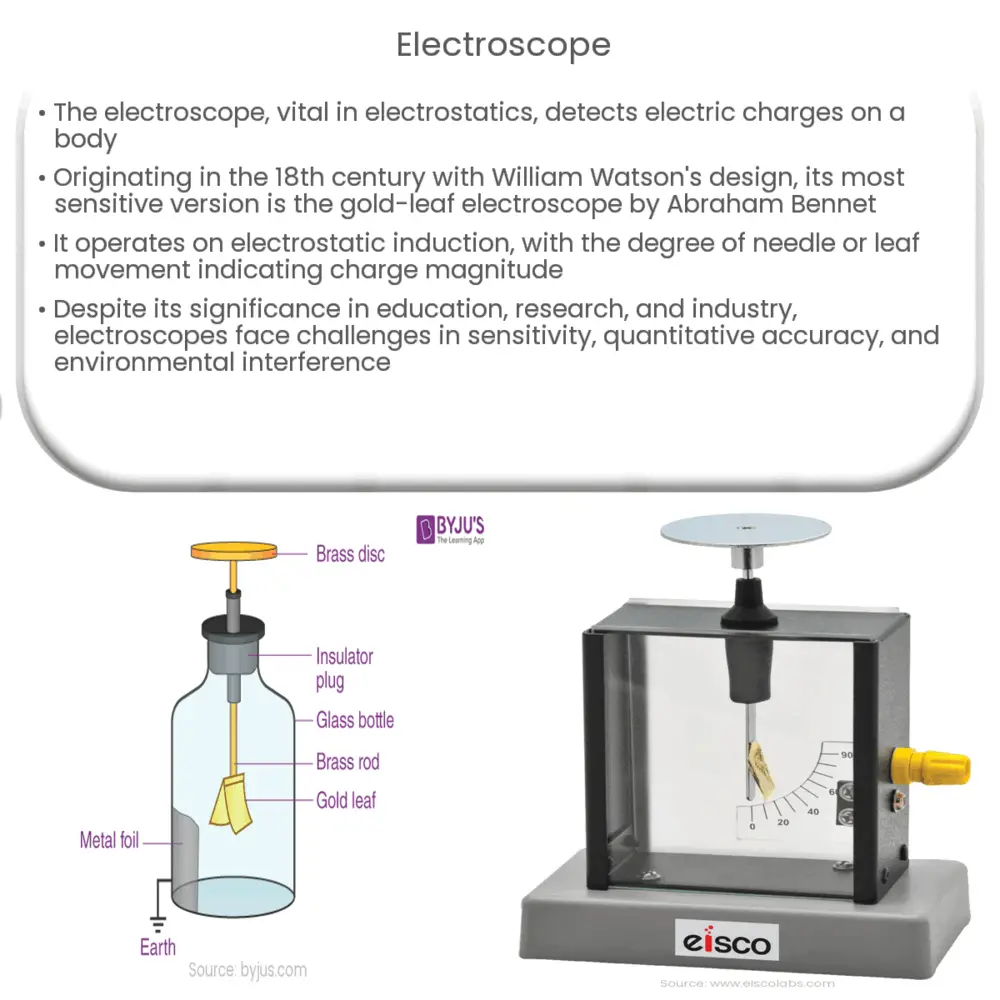An electroscope is a device used to detect electric charge, featuring a metal rod or plate, suspension system, enclosed container, and insulating support.

Understanding the Electroscope: A Journey Through History and Function
An electroscope is a scientific instrument used to detect the presence and magnitude of electric charge on a body. It has been a crucial tool in the field of electrostatics since its invention in the 18th century. In this article, we will explore the history and development of the electroscope, understand its basic principles and components, and discuss its applications and limitations in modern science.
A Brief History of the Electroscope
The invention of the electroscope can be traced back to the early 18th century, when British scientist William Watson developed the first rudimentary version of the device. Watson’s electroscope was a simple apparatus that used a suspended metal wire to detect the presence of an electric charge. Later, in 1762, the Swedish physicist Johan Carl Wilcke introduced a more refined version, known as the pivoted needle electroscope. This device featured a lightweight metal needle that pivoted on a point, allowing it to move more freely in response to the presence of an electric charge.
However, it was the French scientist Abraham Bennet who made a significant breakthrough in 1787 with the invention of the gold-leaf electroscope. Bennet’s design utilized two thin, gold leaves suspended from a metal rod inside a glass container. This design provided a much higher sensitivity to electric charges, allowing for more accurate measurements.
How an Electroscope Works: The Basics
An electroscope operates on the principle of electrostatic induction. When a charged object is brought near the electroscope, the free electrons within the device are either attracted or repelled, depending on the charge of the object. This causes an accumulation of charge on the metal components of the electroscope, which in turn affects the position of the gold leaves or needle.
When the electroscope is charged, the gold leaves or needle experience a repulsive force due to the like charges accumulating on them. This causes the leaves to diverge or the needle to deflect, depending on the design of the electroscope. The degree of divergence or deflection is directly proportional to the magnitude of the charge on the object, allowing the user to estimate the charge’s strength.
Components of an Electroscope
Despite the various designs and refinements over the years, the basic components of an electroscope remain largely the same. These components include:
- A metal rod or plate, which acts as the primary conductor for the device.
- A suspension system for the gold leaves or needle, which allows for free movement in response to the presence of an electric charge.
- A glass or plastic container, which encloses the gold leaves or needle to protect them from external influences such as air currents and humidity.
- An insulating support, which isolates the metal components from the ground to ensure accurate measurements.
Types of Electroscopes
Over the years, various types of electroscopes have been developed to cater to different needs and applications. Some of the most common types include:
- Gold-Leaf Electroscope: As mentioned earlier, this type of electroscope consists of two thin gold leaves suspended from a metal rod. It is known for its high sensitivity to electric charges and is widely used in educational settings and laboratories.
- Pivoted Needle Electroscope: This design features a lightweight metal needle that pivots on a point, allowing it to move freely in response to electric charges. Although less sensitive than the gold-leaf electroscope, it is still widely used due to its durability and ease of use.
- Ball Electroscope: A ball electroscope consists of a metal ball or sphere suspended from a metal rod. When charged, the ball moves towards or away from the rod, depending on the charge of the nearby object. This type of electroscope is primarily used for qualitative demonstrations, as it is not as sensitive as the other designs.
Applications and Limitations of Electroscopes
Electroscopes have a range of applications in various fields, including:
- Education: Electroscopes are widely used in physics classrooms to demonstrate the principles of electrostatics and help students understand the behavior of electric charges.
- Research: In laboratories, electroscopes are used to measure the charge on objects and study the properties of charged particles, such as electrons and ions.
- Industry: Electroscopes are used in industrial settings to detect the presence of static electricity, which can cause damage to sensitive electronic equipment or pose a fire hazard in certain environments.
Despite their many applications, electroscopes have some limitations:
- Sensitivity: Although gold-leaf electroscopes offer high sensitivity, other types of electroscopes may not be as sensitive, making it difficult to detect very small charges.
- Quantitative measurements: Electroscopes primarily provide qualitative information about the presence and polarity of electric charges. Accurate quantitative measurements typically require more advanced equipment, such as electrometers or oscilloscopes.
- Environmental factors: Electroscopes can be influenced by external factors, such as humidity and air currents, which can lead to inaccurate measurements or false readings.
Conclusion
The electroscope has played a crucial role in the development of our understanding of electricity and electrostatics. From its invention in the 18th century to its modern-day applications, the electroscope remains an important tool for detecting and analyzing electric charges. Despite its limitations, the electroscope continues to be a valuable instrument in educational, research, and industrial settings, helping us explore the fascinating world of electricity and charge.

